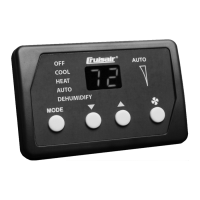Important Programming Notes To Installer and End User Q3 and Qht Controls for Chilled Water Systems
4 L-2962 ENGLISH
IMPORTANT PROGRAMMING NOTES TO INSTALLER AND END USER
Standard air handlers come equipped with chilled-water bypass valves. However, for “no-valve” air handlers, the fan mode must
be set to “Intermittent” via Programmable Function 6. Verify that the installed air handlers have bypass valves; if not, change
Programmable Function 6 to “I” for intermittent fan operation. (See Programmable Function “6: Fan Mode” on page 9 for more
information) Also in this case, please ensure that the ambient air temperature sensor is located somewhere directly exposed to
the cabin space and not located inside of a duct or near the air handler itself.
NORMAL HEATING OR COOLING CYCLE
In Run Mode, heating and cooling are supplied as required. If Cooling is required, the system will start a cooling cycle when the
cabin temperature exceeds the set point by the Bypass Valve Differential setting in Programmable Function 2 (1.5°F/0.8°C by
default) and will continue to cool until the temperature equals the set point. Similarly, if Heating is required, the system will start
a heating cycle when the cabin temperature is below the set point by the Bypass Valve Differential setting and will continue to
heat until the temperature equals the set point.
If you select Cool Mode, only cooling is supplied. If you select (optional) Aux Heat Mode, only heating is supplied. The cabin
temperature in either mode is maintained within the Bypass Valve Differential setting. When the heating or cooling set point is
satisfied, the bypass valve closes.
When cooling is required, the bypass valve will not open unless the loop supply water temperature is at least 10°F less than the
inside cabin temperature Similarly, when heating is required, the bypass valve will not open unless the loop supply water
temperature is at least 10°F greater than the inside cabin temperature. In Auto Mode, which requires an optional aux heater to
be installed and enabled, the aux heater will assist in heating with the bypass valve when the supply loop water temperature is
between 10°F and 20°F greater than the inside cabin temperature. You can view the supply loop water temperature by
simultaneously pressing the MODE and FAN buttons.
During a Cooling or Heating cycle, the fan will operate at a fan speed depending on the fan’s operational mode. If a Manual fan
speed is selected, the fan will operate at this speed at all times, even if the set point has been satisfied and the cooling or
heating cycle has ended. If the fan is in Auto mode, the fan speed will be determined by Programmable Function 3, the Fan
Response Differential, and Programmable Function 18, Fan-Speed Divisions. Please refer to these parameters for further
details on the fan speeds during Auto fan operation. When in Auto fan mode, the fan speed will return to low speed once the set
point temperature has been satisfied and the cooling or heating cycle has ended.
INSTALLING THE DISPLAY PANEL
MOUNTING THE DISPLAY
1. For the Qht display, make a rectangular cut-out in the panel where it will be mounted. The Qht cut-out size is 3-7/16”
(88mm) wide by 2-1/8” (54mm) high. For the Q3 display, only a 1” (26mm) round hole is required in the panel for
mounting.
2. Use the installation instructions included with your display to complete the mounting, securing the display with the
appropriate size and number of screws.
3. Plug one end of the display cable (6-pin connector) to the back of the display and the other end to socket labeled
“Display” located on the edge of the circuit board.
MOUNTING THE SENSORS
AMBIENT TEMPERATURE SENSOR - REQUIRED
Install the ambient temperature sensor in a proper location to accurately sense the room air temperature. Ideally, the sensor
should be located in a reliable return-air stream moving from the room to be controlled to the air handler it is plugged into.
Locating the sensor on the back of the air handler coil is not ideal and can result in false readings for several reasons. It is best
to locate the sensor just inside of a return-air grille or passage. The standard cable length for the remote air sensor is 7 feet
(2.1m). Plug in the sensor’s 6-pin connector to the “Inside Temp” socket located on the edge of the circuit board.
LOOP INLET TEMPERATURE SENSOR - REQUIRED
Install the chilled water loop inlet temperature sensor on the supply pipe that is feeding the air handler. Ensure that the sensor is
in direct contact with the copper pipe and use thermal mastic to ensure good heat transfer. Strap the sensor wire in place for
NOTE
Do not staple any sensor cables when mounting.

